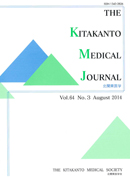Volume 64, Issue 3
Displaying 1-11 of 11 articles from this issue
- |<
- <
- 1
- >
- >|
ORIGINAL
-
2014 Volume 64 Issue 3 Pages 237-242
Published: August 01, 2014
Released on J-STAGE: September 10, 2014
Download PDF (749K)
CASE REPORT
-
2014 Volume 64 Issue 3 Pages 243-248
Published: August 01, 2014
Released on J-STAGE: September 10, 2014
Download PDF (844K)
STREAM
-
2014 Volume 64 Issue 3 Pages 249-250
Published: August 01, 2014
Released on J-STAGE: September 10, 2014
Download PDF (288K) -
2014 Volume 64 Issue 3 Pages 251-252
Published: August 01, 2014
Released on J-STAGE: September 10, 2014
Download PDF (300K)
ABSTRACTS
-
2014 Volume 64 Issue 3 Pages 253-254
Published: August 01, 2014
Released on J-STAGE: September 10, 2014
Download PDF (186K) -
2014 Volume 64 Issue 3 Pages 255-258
Published: August 01, 2014
Released on J-STAGE: September 10, 2014
Download PDF (398K) -
2014 Volume 64 Issue 3 Pages 259-263
Published: August 01, 2014
Released on J-STAGE: September 10, 2014
Download PDF (387K) -
2014 Volume 64 Issue 3 Pages 265-274
Published: August 01, 2014
Released on J-STAGE: September 10, 2014
Download PDF (573K) -
2014 Volume 64 Issue 3 Pages 275-300
Published: August 01, 2014
Released on J-STAGE: September 10, 2014
Download PDF (848K) -
2014 Volume 64 Issue 3 Pages 301-305
Published: August 01, 2014
Released on J-STAGE: September 10, 2014
Download PDF (231K)
EDITOR'S POSTSCRIPT
-
2014 Volume 64 Issue 3 Pages 307
Published: August 01, 2014
Released on J-STAGE: September 10, 2014
Download PDF (122K)
- |<
- <
- 1
- >
- >|
